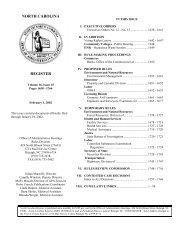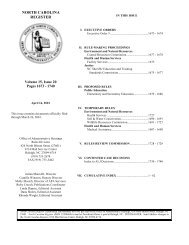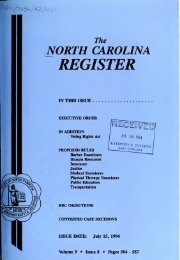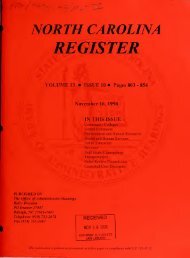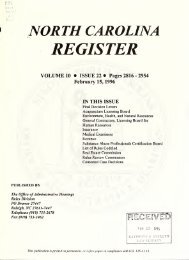NC Register Volume 23 Issue 09 - Office of Administrative Hearings
NC Register Volume 23 Issue 09 - Office of Administrative Hearings
NC Register Volume 23 Issue 09 - Office of Administrative Hearings
Create successful ePaper yourself
Turn your PDF publications into a flip-book with our unique Google optimized e-Paper software.
APPROVED RULES<br />
(b)<br />
Fish habitat areas. The estuarine and<br />
marine areas that support juvenile and<br />
adult populations <strong>of</strong> fish species, as<br />
well as forage species utilized in the<br />
food chain. Fish habitats as used in<br />
this definition, are vital for portions<br />
<strong>of</strong> the entire life cycle, including the<br />
early growth and development <strong>of</strong> fish<br />
species. Fish habitats in all coastal<br />
fishing waters, as determined through<br />
marine and estuarine survey<br />
sampling, include:<br />
(i) Anadromous fish nursery<br />
areas. Anadromous fish<br />
nursery areas are those areas<br />
in the riverine and estuarine<br />
systems utilized by<br />
post-larval and later juvenile<br />
anadromous fish.<br />
(ii) Anadromous fish spawning<br />
areas. Anadromous fish<br />
spawning areas are those<br />
areas where evidence <strong>of</strong><br />
spawning <strong>of</strong> anadromous<br />
fish has been documented in<br />
Division sampling records<br />
through direct observation <strong>of</strong><br />
spawning, capture <strong>of</strong><br />
running ripe females, or<br />
capture <strong>of</strong> eggs or early<br />
larvae.<br />
(iii) Beds <strong>of</strong> submerged aquatic<br />
vegetation. Beds <strong>of</strong><br />
submerged aquatic<br />
vegetation are those habitats<br />
in public trust and estuarine<br />
waters vegetated with one or<br />
more species <strong>of</strong> submerged<br />
vegetation such as eelgrass<br />
(Zostera marina), shoalgrass<br />
(Halodule wrightii) and<br />
widgeongrass (Ruppia<br />
maritima). These vegetation<br />
beds occur in both subtidal<br />
and intertidal zones and may<br />
occur in isolated patches or<br />
cover extensive areas. In<br />
either case, the bed is<br />
defined by the presence <strong>of</strong><br />
above-ground leaves or the<br />
below-ground rhizomes and<br />
propagules together with the<br />
sediment on which the plants<br />
grow. In defining beds <strong>of</strong><br />
submerged aquatic<br />
vegetation, the Marine<br />
Fisheries Commission<br />
recognizes the Aquatic<br />
Weed Control Act <strong>of</strong> 1991<br />
(G.S. 113A-220 et. seq.) and<br />
does not intend the<br />
submerged aquatic<br />
vegetation definition, or<br />
rules 15A <strong>NC</strong>AC 03K .0304,<br />
.0404 and 03I .0101, to<br />
apply to or conflict with the<br />
non-development control<br />
activities authorized by that<br />
Act.<br />
(iv) Nursery areas. Nursery<br />
areas are those areas in<br />
which for reasons such as<br />
food, cover, bottom type,<br />
salinity, temperature and<br />
other factors, young finfish<br />
and crustaceans spend the<br />
major portion <strong>of</strong> their initial<br />
growing season. Primary<br />
nursery areas are those areas<br />
in the estuarine system<br />
where initial post-larval<br />
development takes place.<br />
These are areas where<br />
populations are uniformly<br />
early juveniles. Secondary<br />
nursery areas are those areas<br />
in the estuarine system<br />
where later juvenile<br />
development takes place.<br />
Populations are composed <strong>of</strong><br />
developing sub-adults <strong>of</strong><br />
similar size which have<br />
migrated from an upstream<br />
primary nursery area to the<br />
secondary nursery area<br />
located in the middle portion<br />
<strong>of</strong> the estuarine system.<br />
(v) Shellfish producing habitats.<br />
Shellfish producing habitats<br />
are those areas in which<br />
shellfish, such as clams,<br />
oysters, scallops, mussels,<br />
and whelks, whether<br />
historically or currently,<br />
reproduce and survive<br />
because <strong>of</strong> such favorable<br />
conditions as bottom type,<br />
salinity, currents, cover, and<br />
cultch. Included are those<br />
shellfish producing areas<br />
closed to shellfish harvest<br />
due to pollution.<br />
(vi) Strategic Habitat Areas.<br />
Strategic Habitat Areas are<br />
locations <strong>of</strong> individual fish<br />
habitats or systems <strong>of</strong><br />
habitats that provide<br />
exceptional habitat functions<br />
<strong>23</strong>:<strong>09</strong> NORTH CAROLINA REGISTER NOVEMBER 3, 2008<br />
859




